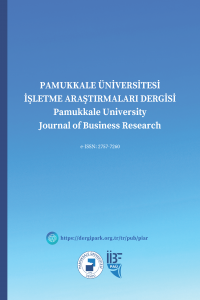Ürün, Kullanıcı Ve Müşteri Odaklı Yaklaşımların Karşılaştırılması
Makalede ürün, kullanıcı ve müşteri odaklı yaklaşımlar piyasa, ürün, soru, metodoloji, inovasyon, rekabetçi avantaj, karlılık, strateji açısından analizi yapılmaktadır. Dünya çapında etkinlik organizasyonu düzenleyen Eventbrite firmasının ürün odaklılıktan kullanıcı odaklı ihtiyaçlara yönelik evrimleşmesiyle ilgili bir örnekte gösterilmiştir. Kullanıcı odaklılık müşteri odaklılıktan farklı olarak pazarlamadaki müşteriye iyi hizmet sunma algısının çok ötesinde kullanıcının faaliyetlerine ve duygularını odaklanılmakta ve onları ilerletmeye yönelik ürün sunulmaktadır. Kullanıcı odaklılık mühendislerin ‘toplam kalite yöntemleri ve altı sigma’ gibi süreç etkinliğine dayalı ve ürün iyileştirmesi sistemlerinden ayrışmaktadır. Etnografik metotlarla kullanıcıyı derinden tanıyıp içgörüler toplanmaktadır. Kullanıcı deneyiminde duygusal, sosyal, bilişsel ve kültürel ihtiyaçlar fiziksel ihtiyaçlara göre ön planda tutmaktadır. Kullanıcıyı tek başına değil ama çevresindeki ekosistemle beraber bütünsel olarak ele almaktadır. Özünde teknoloji kullanıcı deneyiminin aracıdır.
Anahtar Kelimeler:
Ürün Odaklı, Kullanıcı (İnsan) Odaklı, Müşteri Odaklı, Deneyim, Duygu
Comparison of product, user and customer-focus approaches
Comparison of product, user, and customer-centric approaches. In this study, the differences between product, user and customer-centric are analyzed in terms of market, product, inquiry, methodology, innovation, competitive advantage, profitability and strategy. The user-centric approach different from customer-centric focuses on users' activities and emotions and offers products to improve their activities rather than attractively selling the existence goods. The user-centric process is based on ethnographic research by extracting personas to develop the experiences rather than engineers’ total quality methods and six sigma. It prioritizes the user's experience and feeling over functional needs. It treats the user as a whole what they interact with. The example of Eventbrite has been added to a company that organizes the worldwide event to demonstrate the product and user-oriented needs. Technology facilitates experience development.
Keywords:
Product-centric, User-centric, Customer-centric, Experience, Emotion,
___
- Blank, S., (2013). “Why the Lean Start-Up Changes Everything”, Harvard Business Review, 4(2), 34-40.
- Brown, T. (2008). “Design Thinking”, Harvard Business Review, 5(3), 56-65.
- Brown T. (2009). Change by Design: How Design Thinking Transforms Organizations and Inspires Innovation, New York: Harper Business.
- Brown, T., ve Wyatt, J. (2010). “Design Thinking for Social Innovation”, Stanford Social Innovation Review, Winter, pp. 30-35.
- Eventbrite. (2018). New Dimensions on Event Organizations. www.eventbrite.com/newdimesions (erişim tarihi: 10.6.2018)
- Gray, D., Brow, S. ve Macanfo, J. (2010), Gamestorming: A Playbook for Innovators, Rulebreakers, and Changemakers, New York: O’reilly Media.
- Kelley, T. (2005). The Ten Faces of Innovation, New York: Doubleday.
- Kelley, T. ve Kelly, D. (2014). Yaratıcı Özgüven, İstanbul: Optimist yayınları.
- Kumar, V. (2012). 101 Design Methods: A Structured Approach for Driving Innovation in Your Organization, Chicago: Wiley.
- Liedtka J ve Ogilvie, T. (2011). Designing for Growth, New York: Columbia Business School.
- Liedtka, J., King, A. ve Bennett, K. (2014). Solvıng Problems with Design Thinking, New York: Columbia Business School.
- Luma Institute, (2012). Innovating for People-Handbook of Human-Centered Design Methods, Chicago: Luma.
- Luma Institute, (2014). “Innovation Taxonomy”, Harvard Business Review, Jan-Feb.
- Pink, D. (2006). A Whole New Mind, New York, Riverhead Trade.
- Ries, E. (2011). Lean Startup, Chicago: Crown Business.
- Steinbeck, R., (2011). Building Creative Competence in Globally Distributed Courses through Design Thinking, Comunicar, 37(19), 27-35.
- Başlangıç: 2014
- Yayıncı: Pamukkale Üniversitesi
